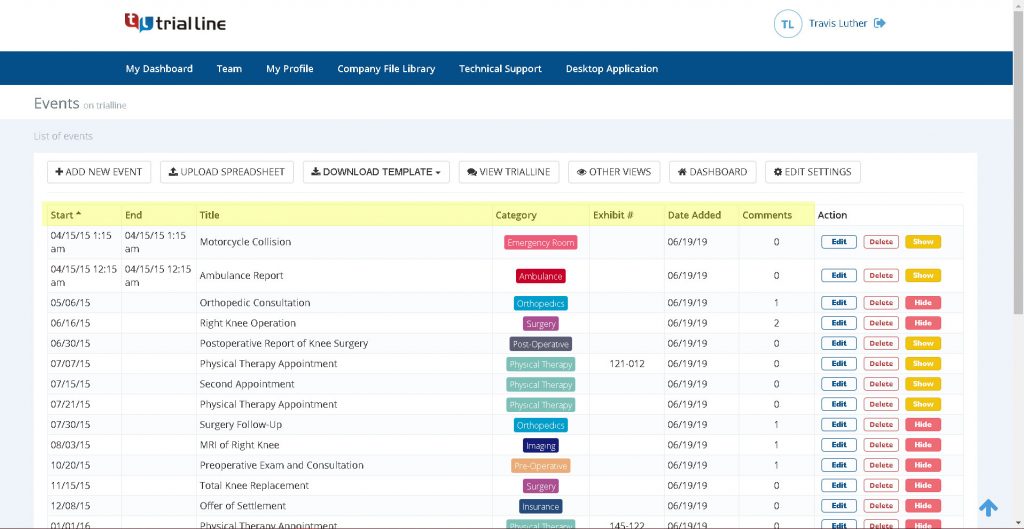In personal injury cases, proving how an accident caused medical conditions requires a clear and structured record. A medical chronology organizes a patient’s medical records by date, creating an easy-to-follow timeline of medical events.
Without a well-prepared medical chronology, attorneys may struggle to extract essential information from voluminous medical records.
By highlighting only what matters, a chronology simplifies case preparation and strengthens legal arguments.
This article will explain how medical chronologies support personal injury cases, what they include, and how they improve case outcomes.
What Is Medical Chronology in Personal Injury Cases?
A medical chronology is a structured document that presents a detailed timeline of a patient’s medical history related to an injury.
It organizes key details from a client’s medical records in chronological order to help attorneys, insurance companies, and courts understand the progression of an injury and its treatment.
Medical record chronologies are often used in legal cases, especially in personal injury, medical malpractice, and mass tort litigation.
These cases involve extensive medical records from multiple healthcare providers. A medical chronology simplifies the review process by highlighting important details such as initial diagnoses, treatments, and long-term effects.
In medical malpractice cases, a well-prepared medical timeline can reveal lapses in care or deviations from standard procedures. By arranging complex information into a clear format, a medical chronology strengthens legal arguments and improves case preparation.
What Is Included in a Medical Chronology?
The following components form the foundation of an effective medical chronology:
Detailed Timeline of Medical Events
An effective medical chronology begins with a concise timeline of the entire process of medical visits, starting from the initial injury through treatment, therapy, and follow-up.
Summarized Treatments and Procedures
Beyond listing appointments, a strong medical chronology provides detailed summaries of procedures, surgeries, and prescribed therapies. These medical information summaries explain to law firms and other parties involved not just what happened but why it was necessary.
Findings From Diagnostic Tests
Objective medical data plays a key role in legal cases. A medical chronology includes results from diagnostic procedures such as X-rays, MRIs, CT scans, and lab reports to substantiate injury claims.
Physician Assessments and Prognosis
A doctor’s evaluation of a patient’s condition carries significant weight in legal assessments. A medical chronology includes physician statements regarding the injury’s cause, the necessity of treatments, and any long-term effects the client may face.
How Medical Chronology Helps Personal Injury Lawyers Build Stronger Cases
Personal injury lawyers need medical records to build strong cases, but reviewing a client’s medical history takes time.
A concise medical chronology highlights key details so attorneys can quickly assess injuries, treatments, and essential medical events. It further helps lawyers to:
Improve Trial Preparation and Legal Strategy
A medical chronology helps legal teams assess a case quickly by providing a structured overview of a client’s medical records.
Instead of spending hours reviewing scattered documents, lawyers can refer to a well-organized timeline that outlines injuries, treatments, and key medical events. This saves time and allows attorneys to focus on case strategy rather than sorting through excessive paperwork.
Paralegals and legal assistants also benefit from a medical chronology since it highlights details that may impact the case. By identifying gaps in treatment or inconsistencies in medical documentation, these chronologies help attorneys build stronger legal arguments.
Judges and opposing counsel can further review the same document to understand the sequence of events without having to interpret complex medical files.
In addition to improving efficiency, a medical chronology helps legal teams:
- Determine if additional medical expert testimony is needed.
- Prepare for depositions by outlining the sequence of events.
- Support settlement negotiations with a clear medical timeline.
- Anticipate potential challenges related to pre-existing conditions.
Strengthen Settlement Negotiations
Reaching fair compensation in personal injury cases requires strong medical evidence that clearly supports the claim. A medical chronology provides a comprehensive overview of a client’s medical background that helps attorneys present a well-documented case.
By organizing complex medical records into a structured timeline, lawyers can highlight key medical facts that demonstrate the severity of injuries and the necessity of ongoing treatment.
Medical chronologies also eliminate confusion by outlining medical records in a clear and logical format. This prevents disputes over conflicting information and helps both parties assess the true extent of damages.
During negotiations, attorneys can:
- Use a structured medical chronology to justify settlement demands.
- Present key medical facts that support claims for long-term care.
- Prevent insurance companies from undervaluing injuries by providing clear medical evidence.
- Show patterns of treatment that support the claim of the ongoing impact of an injury.
Maximize Expert Witness Efficiency
Expert witnesses provide valuable insights in personal injury lawsuits, but reviewing an entire set of medical records is a time-consuming and costly process. A medical chronology report highlights medically significant points, which lets experts focus on key details without unnecessary review.
Unlike a medical record summary, which explains the significance of treatments and conditions, a medical chronology lists medical events in order, making it easier to track injury progression.
For expert testimony, a medical chronology is more effective because it provides a clear sequence of facts without interpretation.
In complex medical cases, this structured approach helps experts:
- Reduce time spent on medical record review.
- Focus on medical records tied to the case.
- Prepare testimony with a clear, fact-based medical summary timeline.
- Simplify communication for attorneys and non-medical personnel.
How to Prepare a Medical Chronology
Follow these steps to create an effective document:
- Collect all medical records – Request hospital records, physician notes, test results, prescriptions, and treatment summaries from all healthcare providers to ensure completeness.
- Arrange records in order – Organize documents chronologically, starting with the initial injury and including all treatments, procedures, and follow-ups.
- Extract key information – Identify crucial details such as diagnoses and treatments. Focus on information that impacts liability, causation, or damages.
- Summarize clearly – Condense treatments, test results, and physician assessments into concise summaries, avoiding unnecessary details.
- Review medical records for accuracy – Check for errors, missing dates, and inconsistencies by cross-referencing with original records.
- Use legal timeline software – Manually organizing medical records can be time-consuming. Legal timeline software can simplify the process by automatically sorting, categorizing, and displaying medical events in an easy-to-read format.
Transform Medical Records Into Winning Legal Timelines With TrialLine
Handling medical records in personal injury lawsuits can be overwhelming. Without a structured system, legal teams risk overlooking key details that could strengthen their case.
TrialLine simplifies this process by converting complex medical records into clear, chronological timelines that present a case in an easy-to-follow format. It allows attorneys to upload and manage documents, images, videos, and other materials, ensuring quick access to relevant information.
By presenting medical chronologies in a structured format, legal teams can identify gaps or inconsistencies in medical records that may impact the case.
With TrialLine, you can manage large volumes of medical data without losing important information. The platform simplifies trial preparation and makes medical proof easier to present during settlement negotiations or in court.
FAQs About Medical Chronology Personal Injury
What is the chronological order of medical records?
The chronological order of medical records follows the sequence in which medical events occurred. It typically starts with the initial incident or diagnosis and progresses through each medical visit, treatment, test result, and follow-up. Organizing records in this way allows legal professionals to track the progression of an injury or illness, identify gaps in treatment, and establish a clear connection between medical events and legal claims.
What is the difference between chronology and summary?
A medical chronology lists medical events in chronological order, showing how an injury or illness progressed. It provides a detailed timeline used for legal and insurance purposes. A medical summary, on the other hand, condenses key information without following a strict timeline. While a chronology tracks medical progress, a summary highlights only the most relevant details.
How to draft a medical chronology?
Drafting a medical chronology starts with collecting all relevant medical records and arranging them in order. The key details, such as diagnoses, treatments, and physician notes, must be extracted and summarized clearly. Reviewing for accuracy ensures that no critical information is missing. Many legal professionals use timeline software to streamline the process and improve clarity.
In which order do medical records typically follow?
Medical records are arranged chronologically, starting with the initial diagnosis or emergency visit. They then progress through physician consultations, treatments, surgeries, and prescribed medications. The sequence ends with follow-ups and final assessments, ensuring a complete and structured record of a patient’s medical history.
Disclaimer: The information provided in this article is for informational purposes only and does not constitute legal advice. Always consult with a qualified attorney or legal professional for advice regarding your specific situation.






